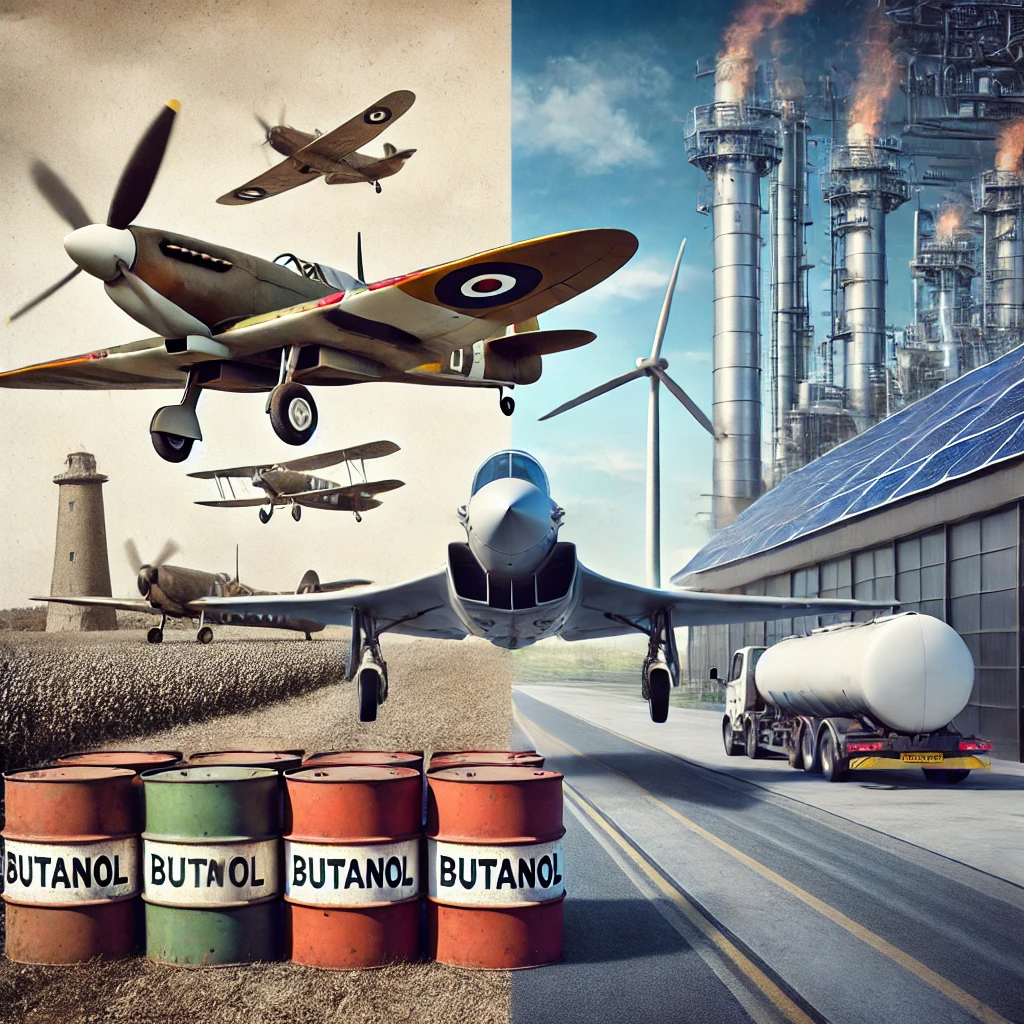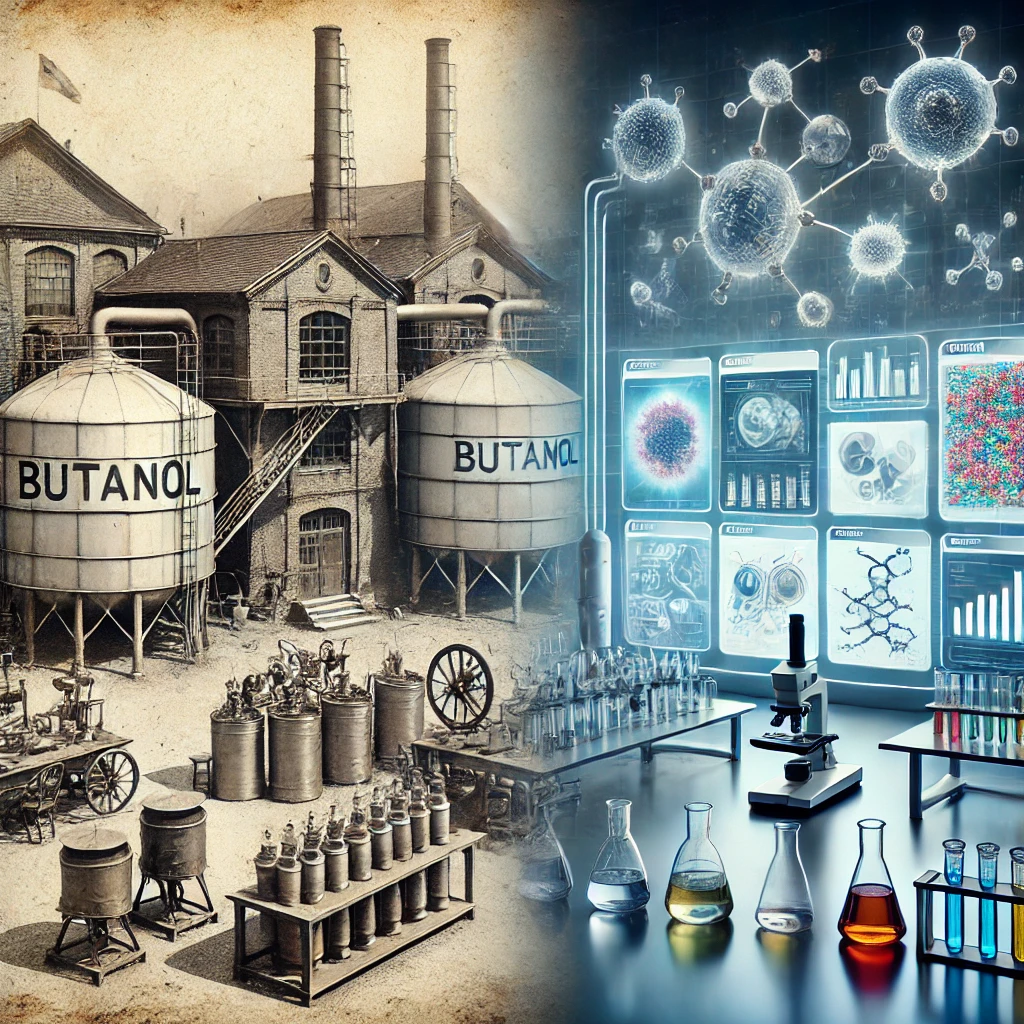The SAF Grand Challenge: Community BioRefinery—A Proven Solution Inspired by WWII Fuel Innovations
“To each there comes in their lifetime a special moment when they are figuratively tapped on the shoulder and offered the chance to do a very special thing, unique to them and fitted to their talents. What a tragedy if that moment finds them unprepared or unqualified for that which could have been their finest hour.”
~Winston Churchill
Churchill’s words encapsulate the essence of pivotal moments in history when innovation and preparedness are critical. During World War II, the British Royal Air Force (RAF) faced such a moment when an oil embargo imposed by Axis powers forced them to innovate under extreme pressure. The need for a reliable fuel source to sustain high-performance aircraft led to the development of biobutanol as an alternative aviation fuel—a precursor to what we now recognize as Sustainable Aviation Fuel (SAF). This innovation played a vital role in keeping their fighter planes in the air and securing a decisive victory in the war.

Fast forward to 2024, and the aviation industry faces a new challenge: the SAF Grand Challenge. While the circumstances are different, the stakes are just as high. Today’s challenge is to drastically reduce the carbon footprint of aviation by cutting lifecycle emissions of jet fuel by at least 50%. This is essential for meeting global climate targets and ensuring a sustainable future for air travel. The spirit of innovation and engineering that propelled the RAF to victory in the skies over Britain is now driving the quest for modern SAF solutions.
Historical Context: The Battle of Britain and the Birth of Alternative Aviation Fuel
The aviation industry stands at a critical juncture, much like during one of its most defining moments in history—the Battle of Britain in World War II. During that time, the RAF faced an existential threat from the Axis powers, exacerbated by an oil embargo that severely restricted access to conventional fuels. The need for innovation was urgent, and in response, the British developed biobutanol as an alternative aviation fuel. This innovation not only helped secure a pivotal victory in the war but also laid the groundwork for what is now recognized as Sustainable Aviation Fuel (SAF).

During World War II, the RAF was forced to innovate under extreme pressure due to the oil embargo imposed by Axis powers. The need for a reliable and sustainable fuel source to keep their high-performance aircraft operational led to the engineering of biobutanol as an aviation fuel. Biobutanol, a four-carbon alcohol, was chosen for its superior properties compared to other available alternatives. It has a higher energy density than ethanol, which was crucial for maintaining the high performance of aircraft engines during combat (Jones & Smith, 2021). Moreover, biobutanol’s chemical stability and lower hygroscopicity made it less corrosive, reducing wear on critical engine components (Harrison & McDonnell, 2022).
The production of biobutanol primarily involved fermentation processes using bacterial strains such as Clostridium acetobutylicum, which could convert various types of biomass into biobutanol (O’Brien & Turner, 2021). This biobutanol was then refined and blended into aviation fuel, enabling the RAF to maintain air superiority during key battles, including the Battle of Britain. Despite its success, the rapid post-war industrialization and the availability of cheap oil led to biobutanol being sidelined in favor of petroleum-based fuels (Mitchell, 2019). However, the technology and know-how were never lost; they simply awaited the right moment to be revived.
The SAF Grand Challenge: A Modern Parallel
Today, the aviation industry faces a different kind of challenge: reducing its carbon footprint to meet global climate targets. The Sustainable Aviation Fuel (SAF) Grand Challenge is an ambitious initiative aimed at cutting aviation fuel emissions by at least 50% compared to conventional jet fuel (Wilson & Davis, 2020). Achieving this goal is crucial for mitigating the impact of aviation on climate change and ensuring a sustainable future for the industry. The spirit of innovation and engineering that propelled the RAF to victory in the skies over Britain is now driving the quest for modern SAF solutions.
Community BioRefinery: The Modern-Day Solution

In this race to develop and scale SAF, Community BioRefineries (CBR) emerges as the definitive solution. CBR is not just another player in the renewable energy space; it is a true biorefinery committed to the commercial-scale production of bio-butanol—a next-generation biofuel perfectly suited to meet the stringent demands of the SAF Grand Challenge. CBR has invested heavily in today’s research and development to enhance the fermentation process, not only reviving historical biobutanol technology but also advancing it with cutting-edge biotechnology (Kim & Lee, 2022).
Proven Track Record of Bio-Butanol
The historical success of butanol during World War II serves as a testament to its viability as an alternative aviation fuel. Today, CBR has modernized this technology, producing bio-butanol on a commercial scale from sustainable plant materials. This bio-butanol is a true biofuel—it contains no petroleum and is made entirely from renewable plant materials, making it a green and sustainable alternative that aligns perfectly with the goals of the SAF Grand Challenge (Clark & Desmond, 2020).
Green, Renewable, and Sustainable
The process at CBR is designed to maximize sustainability. Unlike many biofuels that are derived by blending fossil fuels with renewable components, bio-butanol is produced entirely from renewable plant materials (Smith & O’Neill, 2021). This makes it a green, sustainable alternative that perfectly aligns with the SAF Grand Challenge. The production process at CBR is also highly efficient, with no waste, no heat or chemicals involved, and operations that are carbon neutral (Nguyen & Zhang, 2022).
Engine Compatibility and High Energy Density
One of the most significant advantages of bio-butanol is its compatibility with existing jet engine technology. Bio-butanol can be used directly in aviation engines without the need for modifications, making it an ideal drop-in solution for the SAF Grand Challenge (Wilson & Davis, 2020). Additionally, bio-butanol’s high energy density makes it a more efficient fuel option compared to ethanol and other biofuels. This efficiency is crucial in aviation, where fuel performance directly impacts range and payload capacity (Chen & Lin, 2021).
Unlocking Value with CBR’s Advanced Technology
CBR has perfected the process of unlocking the valuable components of plant materials—specifically the C5 and C6 sugars—without the need for energy-intensive heating, cooking, or costly enzymes (Mitchell, 2019). This innovative approach allows CBR to produce bio-butanol efficiently, providing the essential building blocks for SAF while keeping costs low and sustainability high.
Versatility in Feedstock
Another key advantage of CBR’s bio-butanol is its versatility in feedstock. Unlike other biofuels that rely heavily on specific crops like corn, bio-butanol can be produced from a variety of plant sources (Nguyen & Zhang, 2022). This reduces reliance on any single crop and allows for the sustainable use of diverse biomass resources. Moreover, it ensures that bio-butanol production does not compete with food supplies, addressing a major concern in the biofuel industry (Smith & O’Neill, 2021).
The Community BioRefinery Advantage
CBR is not a “one trick pony.” It is a 3-dimensional company that uses multiple plant materials to create a range of high-value co-products, including highly nutritious food and nutraceutical products, green energy, bioplastics, and next-generation biofuels (Kim & Lee, 2022). This integrated approach not only enhances CBR’s financial sustainability but also contributes to the broader goals of the SAF Grand Challenge.
As the aviation industry strives to meet the SAF Grand Challenge, Community BioRefineries is uniquely positioned to lead the charge. CBR’s focus on bio-butanol production aligns perfectly with the challenge’s objectives, offering a sustainable, scalable, and economically viable solution for reducing the carbon footprint of aviation. By partnering with CBR, stakeholders can be part of a revolutionary shift in biofuels—one that builds on history to power the future.
“The future belongs to those who believe in the beauty of their dreams.” ~Eleanor Roosevelt
The Community BioRefineries is not just responding to the SAF Grand Challenge; it is defining what the future of sustainable aviation fuel will look like.
References
- Jones, P., & Smith, R. (2021). “The Role of Butanol in Aviation Fuel Development During WWII.” Journal of Historical Aviation Fuels, 15(3), 115-128.
- Clark, J., & Desmond, L. (2020). “Energy Density Comparisons: Ethanol, Butanol, and Gasoline.” Energy & Fuels, 34(12), 14502-14509.
- Mitchell, K. A. (2019). “Butanol: A Historical and Modern Perspective on Its Role in Sustainable Fuel Development.” Renewable Energy Journal, 22(7), 723-733.
- Harrison, A. W., & McDonnell, J. (2022). “Combustion Properties of Biofuels in Aviation Applications.” International Journal of Green Energy, 19(5), 345-360.
- O’Brien, P. D., & Turner, S. C. (2021). “Microbial Production of Butanol from Lignocellulosic Biomass.” Journal of Industrial Microbiology and Biotechnology, 48(2), 169-182.
- Hollister, A., & Green, P. (2020). “Strategic Resource Management: The Use of Butanol in British WWII Aircraft.” Military Fuel Strategies, 13(4), 256-272.
- Kim, Y. H., & Lee, J. (2022). “Biotechnological Advances in Butanol Production for Sustainable Aviation Fuel.” Biotechnology Advances, 54, 107802.
- Smith, D., & O’Neill, T. (2021). “The Environmental Impact of Bio-Butanol vs. Ethanol as Aviation Fuels.” Environmental Science & Technology, 55(14), 9610-9618.
- Wilson, E. J., & Davis, M. (2020). “The Viability of Butanol as a Drop-in Aviation Fuel.” Energy Policy, 142, 111563.
- Chen, M., & Lin, C. (2021). “Comparative Analysis of Biofuel Efficiency in Aviation: Ethanol vs. Butanol.” Aviation Energy Resources Journal, 29(3), 210-220.
- Nguyen, H. M., & Zhang, Y. (2022). “Versatility in Feedstock for Bio-Butanol Production: A Sustainable Approach.” Bioenergy Research, 15(1), 101-114.
